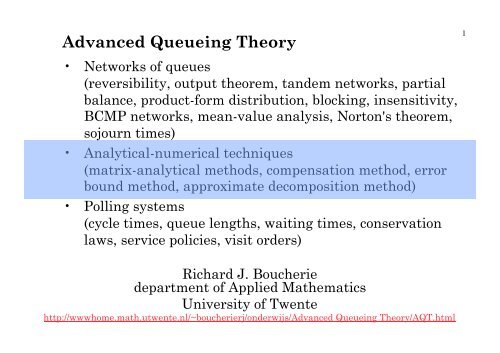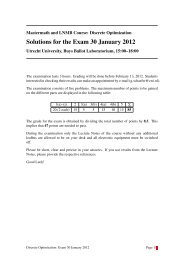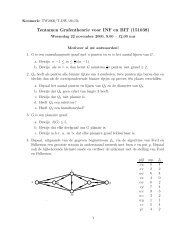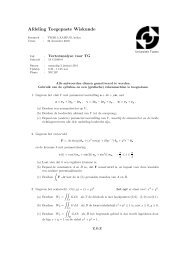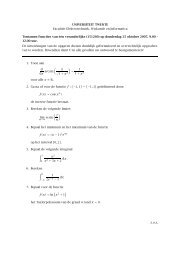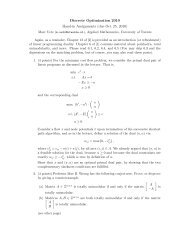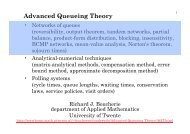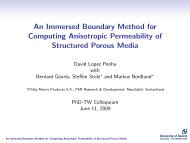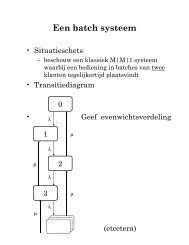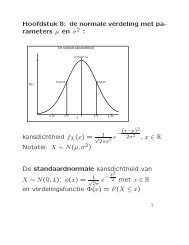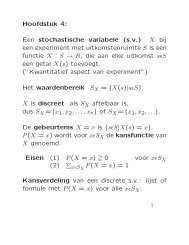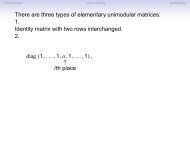Advanced Queueing Theory - Department of Computer Science ...
Advanced Queueing Theory - Department of Computer Science ...
Advanced Queueing Theory - Department of Computer Science ...
You also want an ePaper? Increase the reach of your titles
YUMPU automatically turns print PDFs into web optimized ePapers that Google loves.
<strong>Advanced</strong> <strong>Queueing</strong> <strong>Theory</strong><br />
1<br />
• Networks <strong>of</strong> queues<br />
(reversibility, output theorem, tandem networks, partial<br />
balance, product-form distribution, blocking, insensitivity,<br />
BCMP networks, mean-value analysis, Norton's theorem,<br />
sojourn times)<br />
• Analytical-numerical techniques<br />
(matrix-analytical methods, compensation method, error<br />
bound method, approximate decomposition method)<br />
• Polling systems<br />
(cycle times, queue lengths, waiting times, conservation<br />
laws, service policies, visit orders)<br />
Richard J. Boucherie<br />
department <strong>of</strong> Applied Mathematics<br />
University <strong>of</strong> Twente<br />
http://wwwhome.math.utwente.nl/~boucherierj/onderwijs/<strong>Advanced</strong> <strong>Queueing</strong> <strong>Theory</strong>/AQT.html
2<br />
• Doe na de m/m/1 eerst even de M/E_r/1 expliciet uit<br />
notes<br />
• Laat dan expliciet zien dat generator een blok structuur<br />
heeft<br />
• Ga dan pas naar QBD
<strong>Advanced</strong> <strong>Queueing</strong> <strong>Theory</strong><br />
Today (lecture 7): Matrix analytical techniques<br />
3<br />
• G. Latouche, V Ramaswami. Introduction to Matrix Analytic<br />
Methods in Stochastic Modeling, SIAM, Philadelphia, 1999<br />
• Tutorial on Matrix analytic methods:<br />
http://www-net.cs.umass.edu/pe2002/papers/nelson.pdf<br />
• M/M/1 queue<br />
• Quasi birth death process<br />
• Generalisations
M/M/1 queue<br />
4<br />
• Poisson arrival process rate ,<br />
single server, exponential service times, mean 1/<br />
• State space S={0,1,2,…}<br />
• transition rates :<br />
• Global balance<br />
• Detailed balance<br />
• Equilibrium distribution
0 =<br />
5
<strong>Advanced</strong> <strong>Queueing</strong> <strong>Theory</strong><br />
Today (lecture 7): Matrix analytical techniques<br />
7<br />
• G. Latouche, V Ramaswami. Introduction to Matrix Analytic<br />
Methods in Stochastic Modeling, SIAM, Philadelphia, 1999<br />
• Tutorial on Matrix analytic methods:<br />
http://www-net.cs.umass.edu/pe2002/papers/nelson.pdf<br />
• M/M/1 queue<br />
• Quasi birth death process<br />
• Generalisations
8<br />
Vector state process: example M/E_k/1<br />
• Let service requirement in single server queue be Erlang (k,apple)<br />
• Augment state description with phase <strong>of</strong> Erlang distribution<br />
• State (n,j): n= # customers, j = #remaining phases<br />
• Transitions<br />
(n,j)(n+1,j) arrival (rate apple)<br />
(n,j)(n,j-1) completion <strong>of</strong> phase (j>1) (rate apple)<br />
(n,j)(n-1,k) completion in last phase, dept (n>1,j=1) (rate apple)<br />
(n,j)(0) completion for n=1, (j=1) (rate apple)<br />
(0)(1,k) arrival to empty system (rate apple)<br />
• Picture<br />
• Generator in block structure<br />
• M/Ph/1
Phase and level<br />
9
10<br />
Quasi-birth-death process (QBD)<br />
Q i blocks <strong>of</strong> size M x M
π i blocks <strong>of</strong> size M<br />
12
Theorem: equilibrium distribution<br />
13
14<br />
Stability<br />
Behaviour in phase direction<br />
x stat distrib<br />
over phases<br />
downward drift
15<br />
QBD: Pro<strong>of</strong> <strong>of</strong> equilibrium distribution<br />
For the discrete time case, R(i,j) is the expected number <strong>of</strong><br />
visits to phase j in level 1 before absorption in level 0<br />
for the process that starts at level 0 in phase i
Pro<strong>of</strong>, ctd<br />
18
19<br />
Computing R<br />
• For computation <strong>of</strong> R, rearrange<br />
• Note that Q 1 is indeed invertible, since it is a<br />
transient generator<br />
• Fixed point equation solved by successive<br />
substitution<br />
• It can be shown that
20<br />
Example: E k /M/1 queue<br />
• Let service requirement in single server queue be Exp(apple)<br />
• Let interarrival time be Erlang (k, apple)<br />
• Augment state description with phase <strong>of</strong> Erlang distribution<br />
• State (n,j): n=# customers, j =#remaining phases<br />
• Transitions<br />
(n,1)(n+1,k) arrival (rate apple)<br />
(n,j)(n,j-1) completion <strong>of</strong> phase (j>1) (rate apple)<br />
(n,j)(n-1,j) service completion (n>1) (rate apple)<br />
• Picture<br />
• Generator in block structure
<strong>Advanced</strong> <strong>Queueing</strong> <strong>Theory</strong><br />
Today (lecture 7): Matrix analytical techniques<br />
21<br />
• G. Latouche, V Ramaswami. Introduction to Matrix Analytic<br />
Methods in Stochastic Modeling, SIAM, Philadelphia, 1999<br />
• Tutorial on Matrix analytic methods:<br />
http://www-net.cs.umass.edu/pe2002/papers/nelson.pdf<br />
• M/M/1 queue<br />
• Quasi birth death process<br />
• Generalisations
Generalisations: different first row<br />
22
24<br />
Generalisations: GI/M/1-type Markov chains<br />
• Consider GI/M/1 at arrival epochs<br />
• Interarrival time has general distribution F A with mean 1/<br />
apple<br />
Service time exponential with rate apple<br />
• Probability exactly n customers served during intarr time<br />
• Probability more than n served during intarr time
Generalisations: GI/M/1-type Markov chains<br />
25<br />
• Prob n cust served during intarr time<br />
• Prob more than n served during intarr time<br />
• Transition probability matrix<br />
• Equilibrium probabilities<br />
• Where is unique root in (0,1) <strong>of</strong><br />
where A has distribution F A
26<br />
Generalisations: GI/M/1-type Markov chains<br />
• Markov chain with transition matrix (suitably ordered<br />
states) <strong>of</strong> the form<br />
is called Markov chain <strong>of</strong> the GI/M/1 type
27<br />
Generalisations: GI/M/1-type Markov chains<br />
• Equilibrium distribution<br />
• Where R is minimal non-negative solution <strong>of</strong><br />
• Computation: truncate<br />
• And use successive approximation
28<br />
Generalisations: M/G/1 type Markov chains<br />
• Embedding <strong>of</strong> M/Q/1 at departure epochs gives upper<br />
triangular structure for transition matrix
29<br />
Generalisations: Level dependent rates<br />
• For Markov chain <strong>of</strong> the GI/M/1 type, we may generalise<br />
to allow for level dependent matrices, i.e.<br />
A i (n) at level n, i=0,1,2,…, n=0,1,2,…
30<br />
References and Exercise<br />
• http://www.ms.unimelb.edu.au/~pgt/Stochworkshop2004.pdf<br />
• http://www.ms.unimelb.edu.au/~pgt/Stochworkshop2004-2.pdf<br />
• Exercise: Consider the Ph/Ph/1 queue. Formulate as<br />
Matrix Analytic queue (i.e. specify the transition matrix, and<br />
the blocks in that matrix). For the E 2 /E 2 /1 queue, obtain<br />
explicit expression for R, and give the equilibrium distribution


